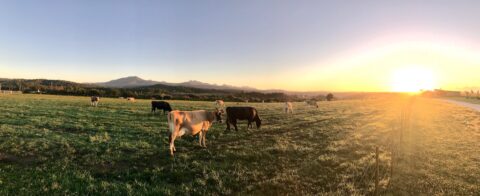Explainer
The Causes and Effects of Deforestation, Explained
Climate•8 min read
Reported
With a growing public demand, two Harvard researchers attempt to answer that question. Over the past decade, there have been growing concerns over how cattle are raised and the way beef is produced. People have grown weary of concentrated animal feeding operations, grain-finished cattle, and livestock farming practices that limit a cow’s ability to perform instinctive practices. This shift in attitude coincides with a growth in the demand for grass-fed beef.


Words by Jonathan Carey
With a growing public demand, two Harvard researchers attempt to answer that question.
Over the past decade, there have been growing concerns over how cattle are raised and the way beef is produced. People have grown weary of concentrated animal feeding operations, grain-finished cattle, and livestock farming practices that limit a cow’s ability to perform instinctive practices. This shift in attitude coincides with a growth in the demand for grass-fed beef.
The overall consumption of beef has declined over the years. But the sale of grass-fed beef has soared. The market exploded in sales from $17 million in 2012 to $272 million in 2016, causing producers to explore the option of shifting to a more natural-sounding feed source for their cattle.
While open grazing is arguably a more natural process to produce beef, debates have sparked about the sustainability of the technique. Some advocates say that with proper management, the process can regenerate land and provide the ground with natural fertilizer. Others say there simply isn’t enough terrain to sustain a growing grass-fed animal industry.
To investigate these questions, Matthew Hayek, a farmed animal law and policy fellow at Harvard University and Boston University associate professor, Rachael D Garrett applied a grass-fed model to the current cattle industry in the United States. Their goal was to discover what is the environmental and land resource cost if all the nation’s cattle were pasture-raised. Previous studies on the matter have been done, but Hayek and Garrett point out considerations that haven’t been sufficiently taken into account, such as the fact that grass-fed cows grow slower and grow to be smaller than their grain-finished kindred.
[infogram id=”_/Ubq3zvBEvqzVz9GHiTHo” prefix=”qPQ” format=”interactive” title=”Grass fed cows daily growth rate”]
They determined that for a grass-fed system to work, we would need much more cattle. Cows that are grass-fed as opposed to those being fed grain during the finishing process take much longer to fatten for market, this new system would require 30% more cattle – around 23 million more cows annually – to produce the amount of beef currently in production. Due to the smaller slaughter weight, over 5 million additional animals would need to be slaughtered at a total of around 27 million cows per year. Due to the fact that the majority of the increase comes from the animals not being finished on the feedlots for slaughter implies another interesting truth: at any given time, there are five times more cows grazing on pastureland before being moved to the concentrated feedlots. This also creates the popular impression that most of the cows live in the open pastureland; alas, this is a temporary state of existence.
[infogram id=”_/9RM2yBGGkPzf98Wpx25t” prefix=”WIp” format=”interactive” title=”Comparing cattle”]
This volume to satisfy demand creates another conundrum: with additional cattle come increased methane emissions. For cattle to digest natural grasses, they first must ferment them in their stomachs. The result of this process according to the study is an increase in methane emissions by 43% compared to conventional methods of producing beef. This would contribute to an 8% jump in the whole country’s overall methane output.
The research also considered the other common concern about the grass-fed model: availability of land. If turned to grass-fed, the current pasture land in the U.S. could support only 27% of the cattle raised today. This isn’t the only hurdle, most of the grasslands across the country experience cold and dry seasons when grasses won’t grow. To compensate for these spells in weather, forage crops such as hay and alfalfa will be needed to sustain the cattle. However, we would still only reach about 61% of our current beef production. Lastly, these crops would compete for land and soil space with food crops that could lead to shortages. Around 67% of the U.S. landmass would have to be dedicated to feeding cattle under this model, up from the 41% today. If forage crops were not used at all the equivalent of 152% of U.S. land would be required for cattle.
According to their findings, the only way an entirely sustainable grass-fed system could exist in the United States is if our desire for beef on the dinner plate decreased. With lower consumer demand everyone stands to benefit, from the environment to the animals to the consumers themselves.